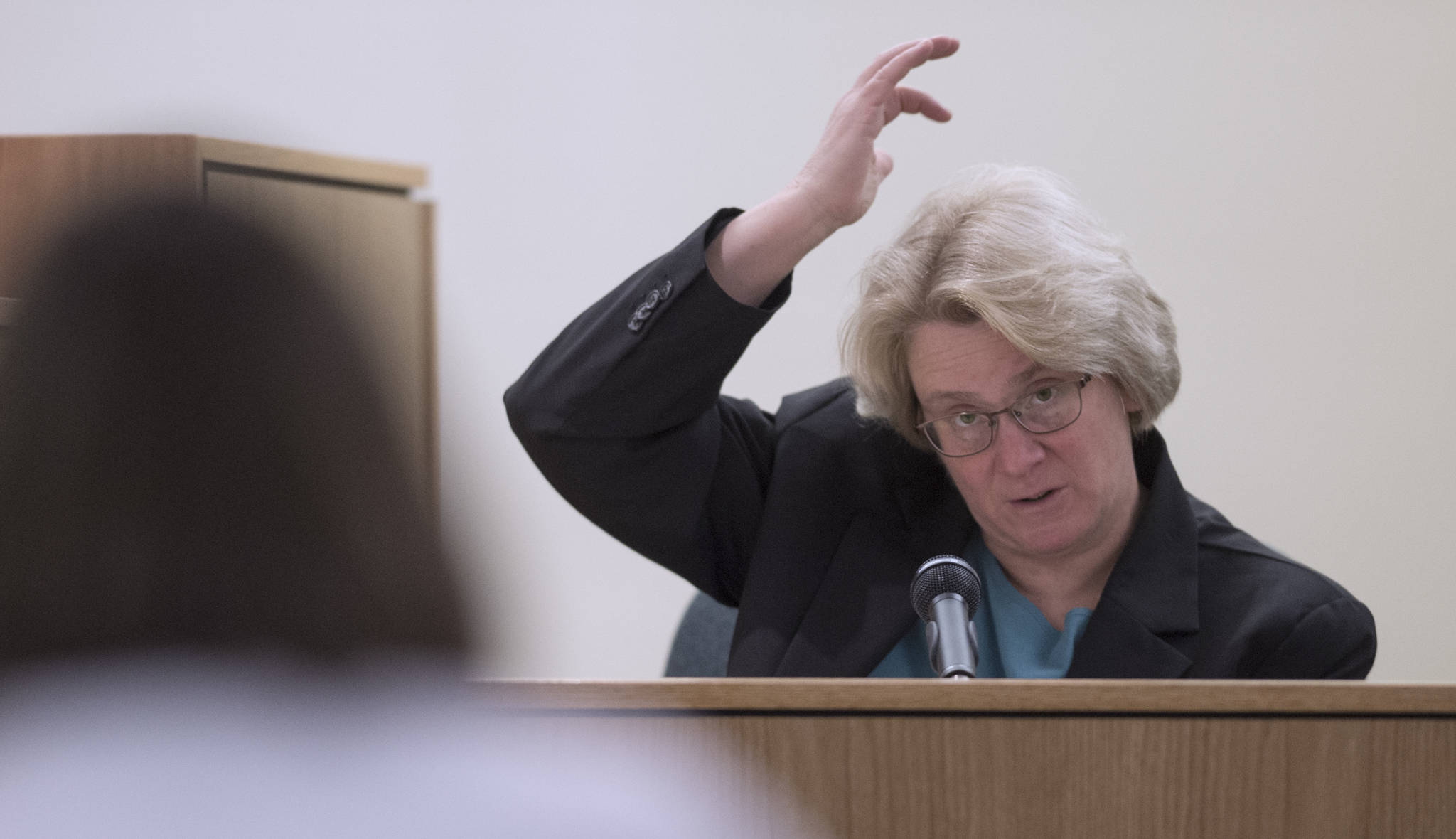Deputy State Medical Examiner Cristin Rolf spent about an hour on the witness stand Thursday explaining the details of the autopsy, but her conclusion was brief.
“The cause of death is brain injury due to gunshot wounds to the head,” Rolf said in court, “and the manner of death is homicide.”
She was referring to her May 17, 2016, autopsy of Duilio Antonio “Tony” Rosales, who was killed two days earlier when he was shot in the back of the head on a hunting trip to Excursion Inlet near Juneau. The man accused of pulling the trigger, Mark De Simone, is currently on trial and facing murder charges.
Rolf was the key witness on the fourth day of witness testimony in the case, and spoke in depth about the injuries two bullets from a Ruger Magnum Blackhawk revolver inflicted on Rosales.
Rolf, who said she has done about 4,000 autopsies in Alaska and Kentucky, said she comes to two main conclusions when she’s done with an autopsy: the cause of death and the manner of death.
The cause of death, she said, is the medical issue that resulted in death. She went into great detail explaining this, saying the two bullets passed through Rosales’ head but did not actually come in contact with his brain. The force with which the bullets went through, she said, actually created a “shock wave” that damaged the brain and skull so much that it killed Rosales.
The manner of death, she said, is how the medical issue happened. In this case, she said she was trying to determine if it was a suicide or homicide. The fact that there were two gunshot wounds behind the right ear, she said, made that determination fairly easy.
“It’s tough for a person to shoot themselves that way, and also it’s two gunshot wounds,” Rolf said. “After the first (shot to the head), the person is most likely unconscious.”
Rolf also said she takes the law enforcement investigation into account when she determines a manner of death. She said the Alaska State Trooper investigation at the time was that another person — De Simone — shot Rosales.
During cross-examination from Assistant Public Defender Deborah Macaulay, Rolf said it is not her job to determine the intent of the shooter. She made no determination about whether the shooter intended to kill Rosales.
At the outset of the trial, Judge Philip Pallenberg read through the indictment, listing off the differences between the “five different levels of homicide,” as he called them. The issue of intent sets the charges apart, as first-degree murder is defined on the indictment as intentionally causing the death of another person. The indictment defines one charge of second-degree murder as intending to cause serious harm to another person and another charge of second-degree murder as having “an extreme indifference to the value of human life.”
The final two charges, of manslaughter and criminally negligent homicide, are “recklessly” causing the death of another person and causing death with “criminal negligence,” respectively.
At the close of the case, it will be up to the jury to determine the level of intent with which De Simone — who allegedly admitted the shooting to multiple witnesses — shot and killed Rosales. Pallenberg said Thursday that both attorneys are optimistic that the jury should be deliberating by the end of next week.
Looking at the gun
Rolf said the gun — a Ruger .41 Magnum Blackhawk revolver that was recovered at the scene — was “within inches” of Rosales’ head when it fired the fatal shots.
She said she could tell this because there was something called stippling on Rosales, where parts of powder and gases from the gun come out and leave little marks on the skin. Rolf said she found stippling on the right side of Rosales’ head, on the forehead, cheeks and around the ear.
She said the gun wasn’t pressed up against the head, because when a gun is pressed up against someone and goes off, it basically sears the skin. It turns the skin black, she said. In other words, she said, the gun was within about 18 inches of Rosales’ head when it went off, Rolf estimates.
Debra Gillis, a forensic firearm and tool marks examiner for the Alaska Scientific Crime Detection Laboratory in Anchorage, spoke at length about the gun. She had it with her on the stand and gestured to it as she explained how it works.
She explained that this gun is single-action, which means you have to cock the hammer and pull the trigger for each shot. The trigger can only fire the gun, she says. It cannot cock the hammer like a double-action trigger can. Gillis also said she examined De Simone’s clothing and found bloodstains on his jeans and T-shirt. There were no stains on the gun, she said.
• Contact reporter Alex McCarthy at 523-2271 or amccarthy@juneauempire.com. Follow him on Twitter at @akmccarthy.

